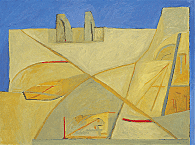|
Albuquerque painter Emily Trovillion defined intuitive art in an artist's statement: "...the understanding of the
structure of things through non-logical or non-empirical means. An intuitive artist must have a metaphoric mind," she said.
Charlotte Jackson deals with art that uses simplicity to achieve complex objectives. She is concerned about the wide use
of the term minimalism.
"People have forgotten that minimalism was an art movement that became prominent during the 1960s. It was a reaction
against gestural painting. The term minimalism is a dated and inappropriate term applied to contemporary art that has nothing to do with
minimalism's original intentions," Jackson said.
Monochrome painting began in 1919 with White on White by Kasimir Malevich. A year later Alexander Rodchenko
created primary color paintings. Artists like Ellsworth Kelly continued to develop monochromatic painting. Painters using one color toyed
with the idea that painting was dead. But art writers like Carter Ratcliff postulate that monochromatic painting may have led to an elemental
rebirth of the medium.
Of course contemporary realist painters think all of these ideas are silly since realism along with its nineteenth century
effete sophistication has survived all insults and is alive and well.
Post-modernism is a catch-all term like contemporary art. Modernism gave birth to constructivism, suprematism,
cubism, futurism, rayonism, orphism, productivism, surrealism, fauvism, dadaism, expressionism, neo-plasticism, concrete art and more before
succumbing to assaults from abstract expressionism, color field painting, monochromism, pop-art, opt art, minimalism, conceptual art, neo-classicism,
structuralism as put forth by French philosopher Michel Foucault and the German Zero Group.
Depending on which historian you believe, modernism ended somewhere between 1950 and 1980. Whatever the date all of the
modern "isms" have fallen, domino style, into the post-modernist melting pot where literally anything goes. For those of us who
grew up in the 1960s a radical was a political protester. But, Charlotte Jackson Fine Art in Santa Fe specializes in radical art which
has nothing to do with politics.
Radical art is related to the roots or origins of art. It can be abstract, atonal, monochromatic, concrete, non-referential
and fundamental. Radical art can form the foundation or basis for extreme change from accepted traditional forms.
Zeitgeist for German philosopher Hegel meant the spirit of the age that was supposed to ensure a homogenous quality
in art, science, literature and music during a particular period. His view was that synthesis was the highest order of truth. As we exit
the twentieth century our zeitgeist is lost somewhere in a sea of words, ideas, opinions, cyberspace travel and bollixed Mars missions.
The next time someone catches you in front of something indescribable in a gallery, just pause and slowly take a half
step back. With hand on chin in serious contemplation and in a voice barely over a whisper say, "It makes its own silent statement".
They'll never know how confused you are.
|


